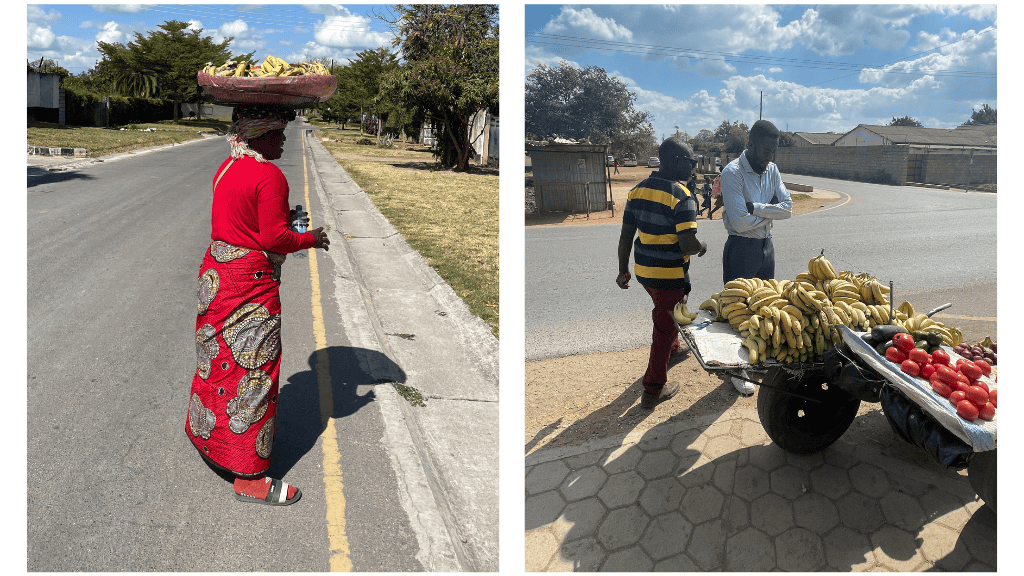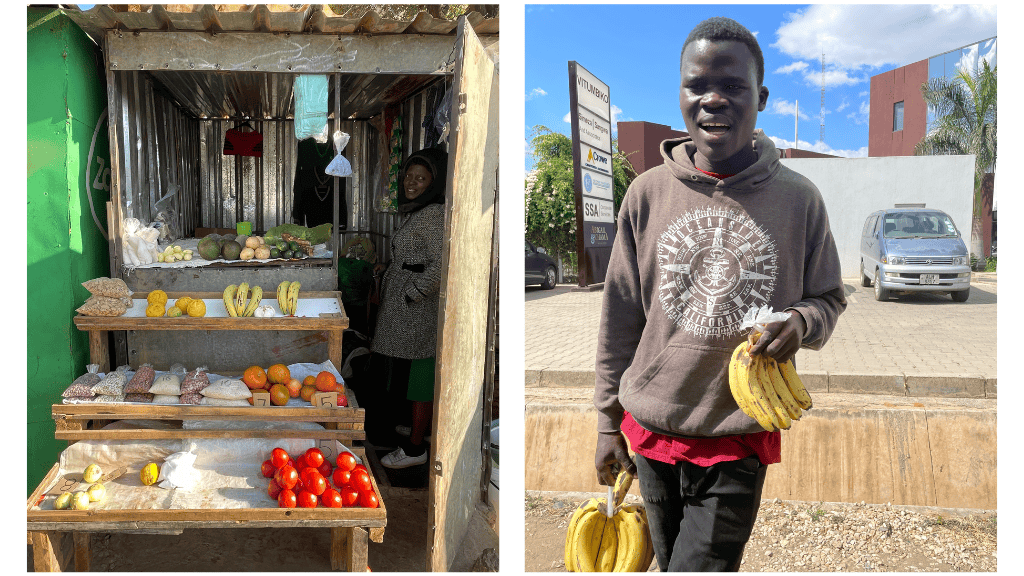Welcome back to the last blog post in my Journey of a Banana series! Morning in Lusaka brings with it a familiar sight: fruit sellers. Wheelbarrows, stands, head baskets—each loaded with bananas, placed or moved across the city. If you’ve been following The Journey of the Banana (Part I and Part II), you’d know that my time in Lusaka, dotted with daily banana purchases, led me to understand these sellers better. From street vending in African cities to how these sellers navigate Lusaka, we’ve covered a lot.
But beyond the broader patterns and trends, every story has a human side. Behind every banana sold on Lusaka’s streets, there’s a seller with a different strategy. Today, we’ll dive deeper into the varied approaches of wheelbarrow sellers, explore the gender dynamics in the trade, uncover the logic behind their location choices, and understand banana pricing.
Join me as we peel back the final layers of Lusaka’s banana trade, one seller at a time.
One Wheelbarrow Seller, One Story
Every seller has a different strategy. And I want to prove it to you by zooming in on the wheelbarrow sellers. Why? Firstly, they were the most common business type in my interviews. But, more importantly, the diversity of their operations caught my eye. As a customer, all you see is the same pile of bananas loaded on a wheelbarrow on the side of a road. But, in my interviews, I broadly categorized them into two main categories: stationary and non-stationary.
Non-stationary sellers like Brian¹ are constantly on the move. They use their wheelbarrows as mobile units, wandering through the city to maximize sales opportunities. This mobility allows them to adapt to varying customer flows and locations throughout the day. In contrast, stationary sellers like Peter choose a specific spot to conduct their business. They set up their wheelbarrows in one location, creating a stable and recognizable point for regular customers.
Some sellers blend these two approaches. For example, Steven transports his goods to a chosen location using his wheelbarrow but then remains stationary for the day’s sales. This hybrid method combines the benefits of mobility in sourcing products with the stability of a fixed selling spot.

Gender Dynamics in Lusaka’s Street Selling
All the wheelbarrow sellers I interviewed were male. But where are all the ladies? They navigate Lusaka differently. While both women and men sell from informal stands, there’s one ‘tool’ predominantly used by women: the head basket.

Grace lives in the John Laing area and starts her day by taking a minibus to the Soweto Market. There, she fills her head basket with bananas and then spends her day walking around Lusaka, selling. Grace’s method utilizes her mobility; the head basket, traditionally employed by Zambian women, allows her to move around easily. She directly approaches potential buyers and shifts locations based on where the demand is throughout the day. After a tiring day of selling, Grace either walks or takes a minibus back home.
Location, Location, Location
Every banana seller in Lusaka seems to have a reason for choosing their particular spot. Here’s a closer look at the factors influencing their decisions.
Vivian sets up her semi-formal stand at a large roundabout, clustered with other stands. She benefits from the presence of other sellers (agglomeration economy) and the frequent flow of potential customers at such a busy spot.
Sam’s approach is a bit more dynamic. By targeting drivers at crossroads, he taps into the convenience factor. He figures people would appreciate a quick snack while they wait, and he’s there to provide just that.
Peter has positioned himself near sports facilities on Thabo Mbeki Road. He’s catering to regular pedestrians and those who’ve just finished a game or a workout. They might be hungry or just looking for a quick energy boost.
Celestine’s choice to sell near a hospital is both personal and strategic. It’s close to her home, which is convenient. But she also knows that it’s a tradition to bring fruits when visiting the unwell in Zambia. She and many other banana sellers around the hospital offer visitors an easy solution.
Martha believes that changing locations exposes her to different groups of people, increasing her chances of sales.
Each seller’s location isn’t just a random choice; it’s a blend of their personal preferences, observations, and a bit of intuition. Their strategies echo Hotelling’s Law from retail location theory, suggesting businesses with similar products cluster together for better customer access. This concept is clearly seen in Vivian’s roundabout stand and Celestine’s hospital spot, both chosen for optimal customer convenience.

How Much for a Banana in Lusaka?
Banana prices are pretty consistent across Lusaka. Whether buying from a street seller or a supermarket, bananas usually cost 2 to 3 Kwacha each (about $0.13). But there’s variation in size and quality. For instance, Brian sold me larger, high-quality bananas for 3 Kwacha each, while Rose at the Soweto Market offered six smaller bananas for just 5 Kwacha.
The retail price of bananas in Lusaka is influenced by the sellers’ wholesale purchase costs. For example, a crate of bananas, weighing around 17 kg, can be purchased wholesale for about 140 to 150 Kwacha. The average weight of a smaller banana is around 100 grams, which equates to a cost of approximately 0.82 Kwacha per banana for the seller. Consequently, when bananas are sold for 2 to 3 Kwacha each, sellers make a profit of about 1.18 to 2.18 Kwacha per banana, balancing affordability for consumers with viability for vendors.
Another factor that influences banana prices is the season. From my interviews in Lusaka, I learned that during the rainy season, sellers increase their prices due to challenges in transportation and potential impacts on banana quality. Some even pause sales during heavy rains. However, this phenomenon might not be observed everywhere in Africa. One study in Kenya, for instance, found that the rainy season can lead to lower banana prices, suggesting regional variations in how weather affects the market.
So, when shopping for bananas in Lusaka, expect consistent prices, but be mindful of potential changes during the rainy months.

Concluding the Journey of a Banana
So, what did my research into Lusaka’s banana trade teach me? Reflecting on my time in Lusaka, I realized that the reality of banana selling was quite different from what I had expected.
Firstly, the uniform pricing of bananas across the city was unexpected. I had anticipated variations in price, especially in busier or more central areas, but this wasn’t the case.
Secondly, the volume of bananas sold on the streets surprised me. This was particularly striking, considering one taxi driver’s comment that Zambians typically consume fruits and bananas mainly when they are sick, rather than as a regular staple in their diet.
I had also assumed there would be some level of coordination among banana sellers, or that their methods or modes of transportation would be similar. However, I discovered that each seller had their unique approach, showing a range of strategies and a lack of communication among vendors.
The clear gender division in selling methods was another interesting find. I noticed that women predominantly used head baskets, while men operated wheelbarrows. This difference seemed to reflect aspects of local culture and practices.
Finally, at the beginning of my research, I wasn’t sure how open the vendors would be about sharing their stories. I was pleasantly surprised and grateful for their warmth and openness, which made my research more insightful and fun.
So there you have it. With the Journey of a Banana, we’ve delved deep into the streets of Lusaka, shadowing banana sellers and unraveling their unique ways. As we wrap up this journey, I want to thank you for being a part of it (and hope you aren’t too sick of bananas because of me). Here’s to going bananas!

¹ I am not using the real names of the interviewed banana sellers.







